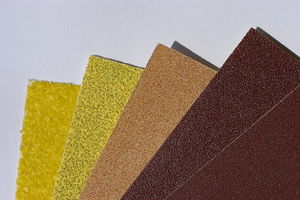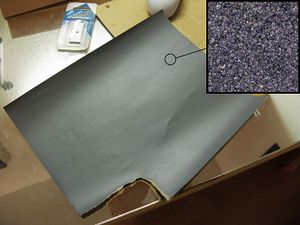Sandpaper
Sandpaper is a form of paper where an abrasive material has been fixed to its surface.
Sandpaper is part of the "coated abrasives" family of abrasive products. It is used to remove small amounts of material from surfaces, either to make them smoother (painting and wood finishing), to remove a layer of material (e.g. old paint), or sometimes to make the surface rougher (e.g. as a preparation to gluing).
History
The first recorded instance of sandpaper was in 13th century China when crushed shells, seeds, and sand were bonded to parchment using natural gum.
Shark skin was also used as a sandpaper. The rough scales of the living fossil Coelacanth are used by the natives of Comoros as sandpaper.Template:Fact
Sandpaper was originally known as glass paper, as it used particles of glass. Glass frit has sharp-edged particles and cuts well, sand grains are smoothed down and did not work as well as glass. Cheap counterfeit sandpaper has long been passed off as true glass paper; Stalker and Parker cautioned against it as far back as the 17th century.<ref name="Stalker & Parker 1688" >Template:Cite book</ref>
Glass paper was manufactured by John Oakey's company in London by 1833, who had developed new adhesive techniques and processes that could be mass-produced. A process for making sandpaper was patented in the United States on June 14, 1834 by Isaac Fischer, Jr., of Springfield, Vermont.
In 1916, 3M invented a type of sandpaper with a waterproof backing, known as Wetordry. This allowed use with water as a lubricant, and to carry about particles that would otherwise clog the finest grades. Its first application was for automotive paint refinishing.
Sandpaper has occasionally been used as a surface for painting, as by Joan Miró. Sandpaper was even used as a musical instrument, in Leroy Anderson's Sandpaper Ballet.
Boiled and dried, the rough horsetail is used in Japan as a traditional polishing material, finer than sandpaper.
Types of sandpaper
There are countless varieties of sandpaper, with variations in the paper or backing, the material used for the grit, grit size, and the bond.
Backing
In addition to paper, backing for sandpaper includes cloth (cotton, polyester, rayon), PET film, and "fibre" ,or rubber. Cloth backing is used for sandpaper discs and belts, while mylar is used as backing with extremely fine grits. Fibre or vulcanized fibre is a strong backing material consisting of many layers of polymer impregnated paper. The weight of the backing is usually designated by a letter. For paper backings, the weight ratings range from "A" to "F," with A designating the lightest and F the heaviest. Letter nomenclature follows a different system for cloth backings, with the weight of the backing rated J, X, Y , T, and M, from lightest to heaviest. A flexible backing allows sandpaper to follow irregular rounded contours of a given workpiece; relatively inflexible backing is optimal for regular rounded or plane surfaces. Sandpaper backings may be glued to the paper or form a separate support structure for moving sandpaper, such as used in sanding belts and discs. Stronger paper or backing increases the ease of sanding wood, so decent quality sand paper is much better than low cost and low quality sandpaper. The harder the backing material is behind the sandpaper, the faster the sanding, the faster the wear of the paper and the rougher the sanded surface.
Material
Materials used for the abrading particles are:
- flint: no longer commonly used
- garnet: commonly used in woodworking
- emery: commonly used to abrade or polish metal
- aluminium oxide: perhaps most common in widest variety of grits; can be used on metal (i.e. body shops) or wood
- silicon carbide: available in very coarse grits all the way through to microgrits, common in wet applications
- alumina-zirconia: (an aluminium oxide–zirconium oxide alloy), used for machine grinding applications
- chromium oxide: used in extremely fine micron grit (micrometre level) papers
- ceramic aluminum oxide: used in high pressure applications, used in both coated abrasives, as well as in bonded abrasives.
As well, sandpaper may be "stearated" where a dry lubricant is loaded to the abrasive. Stearated papers are useful in sanding coats of finish and paint as the stearate "soap" prevents clogging and increases the useful life of the sandpaper. Aluminium Oxide with stearate is also known as PS33, a Klingspor Abrasives product. The harder the grit material, the easier the sanding of surfaces like wood. The grit material for polishing granite slab has to be harder than granite.
Innovative abrading surfaces now include long-life stainless steel sanding discs.
Bonds
Different adhesives are used to bond the abrasive to the paper. Hide glue is still used, but this paper often cannot withstand the heat generated when machine sanding and is not waterproof. Waterproof or wet/dry sandpapers use a resin bond and a waterproof backing.
Sandpapers can also be open coat, where the particles are separated from each other and the sandpaper is more flexible. This helps prevent clogging of the sandpaper. The wet and dry sandpaper is best used when wet and when using material like acrylic where it leaves a nice smooth feel afterwards.
Shapes
Sandpaper comes in a number of different shapes and sizes.
- sheet: usually 9 by 11 inches, but other sizes may be available
- belt: usually cloth backed, comes in different sizes to fit different belt sanders.
- disk: made to fit different models of disc and random orbit sanders. May be perforated for some models of sanders. Attachment includes Pressure sensitive adhesive (PSA) and "hook-and-loop" (similar to velcro).
- rolls: known as "Shag Rolls" by many contractors
Grit sizes
Grit size refers to the size of the particles of abrading materials embedded in the sandpaper. A number of different standards have been established for grit size. These standards establish not only the average grit size, but also the allowable variation from the average. The two most common are the United States CAMI (Coated Abrasive Manufacturers Institute, now part of the Unified Abrasives Manufacturers' Association) and the European FEPA (Federation of European Producers of Abrasives) "P" grade. The FEPA system is the same as the ISO 6344 standard. Other systems used in sandpaper include the Japan Industrial Standards Committee (JIS), the micron grade (generally used for very fine grits). The "ought" system was used in the past in the United States. Also, cheaper sandpapers sometimes are sold with nomenclature such as "Coarse", "Medium" and "Fine", but it is not clear to what standards these names refer.
Grit size table
The following table, compiled from the references at the bottom, compares the CAMI and "P" designations with the average grit size in micrometres (µm).
| ISO/FEPA Grit designation | CAMI Grit designation | Average particle diameter (µm) | |
|---|---|---|---|
| MACROGRITS | |||
| Extra Coarse (Very fast removal of material, hardwood flooring initial sanding) | P12 | 1815 | |
| P16 | 1324 | ||
| P20 | 1000 | ||
| P24 | 764 | ||
| 24 | 708 | ||
| P30 | 642 | ||
| 30 | 632 | ||
| 36 | 530 | ||
| P36 | 538 | ||
| Coarse (Rapid removal of material) | P40 | 40 | 425 |
| 50 | 348 | ||
| P50 | 336 | ||
| Medium (sanding bare wood in preparation for finishing, for gentle removal of varnish) | 60 | 265 | |
| P60 | 269 | ||
| P80 | 201 | ||
| 80 | 190 | ||
| Fine (sanding bare wood in preparation for finishing, not suitable for removing varnish or paint from wood, use for cleaning plaster and water stain from wood) | P100 | 162 | |
| 100 | 140 | ||
| P120 | 125 | ||
| 120 | 115 | ||
| Very Fine (sanding of bare wood) | P150 | 100 | |
| 150 | 92 | ||
| P180 | 180 | 82 | |
| P220 | 220 | 68 | |
| MICROGRITS | |||
| Very Fine (sanding finishes between coats) | P240 | 58.5 | |
| 240 | 53.0 | ||
| P280 | 52.2 | ||
| P320 | 46.2 | ||
| P360 | 40.5 | ||
| Extra fine, start polishing of wood | 320 | 36.0 | |
| P400 | 35.0 | ||
| P500 | 30.2 | ||
| 360 | 28.0 | ||
| P600 | 25.8 | ||
| Super fine (final sanding of finishes, final sanding of wood) | 400 | 23.0 | |
| P800 | 21.8 | ||
| 500 | 20.0 | ||
| P1000 | 18.3 | ||
| 600 | 16.0 | ||
| P1200 | 15.3 | ||
| Ultra fine (final sanding and polishing of thick finishes) | P1500 | 800 | 12.6 |
| P2000 | 1000 | 10.3 | |
| P2500 | 8.4 | ||
See also
- Coated abrasive
- Steel wool
- Emery (mineral)
- Polishing
- Belt sander
- Dremel
- Grinding machine
- Sander
- Particle size (grain size)
References
Template:Commonscat Template:Reflist
Bibliography
- Michael Dresdner (1992). The Woodfinishing Book. Taunton Press. ISBN 1-56158-037-6
- Federation of European Producers of Abrasives
- sizes.com on sandpaper
- Paper Talk
cs:Brusný papír da:Slibemiddel pdc:Sandbabier de:Schleifpapier et:Abrasiivpaber es:Papel de lija fa:سنباده fr:Papier de verre gd:Pàipear-gainmhich id:Amplas it:Carta abrasiva lb:Glaspabeier nl:Schuurpapier ja:紙やすり no:Sandpapir nn:Sandpapir pl:Papier ścierny pt:Lixa ru:Шлифовальная шкурка szl:Glancpapjůr fi:Hiomapaperi sv:Sandpapper th:กระดาษทราย

